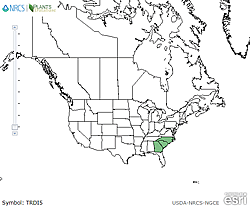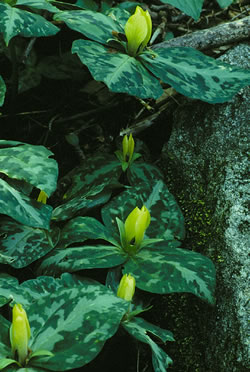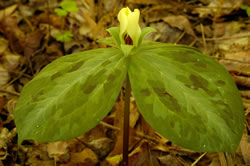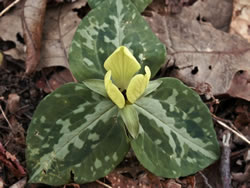Plant of the Week
 Trillium decumbens range map. USDA PLANTS Database.
Trillium decumbens range map. USDA PLANTS Database.
 Mottled Wakerobin (Trillium discolor). Photo by Gary Kaufmann.
Mottled Wakerobin (Trillium discolor). Photo by Gary Kaufmann.
 Mottled Wakerobin (Trillium discolor). Photo by Hugh and Carol Nourse.
Mottled Wakerobin (Trillium discolor). Photo by Hugh and Carol Nourse.
 Mottled Wakerobin (Trillium discolor). Photo by Hugh and Carol Nourse.
Mottled Wakerobin (Trillium discolor). Photo by Hugh and Carol Nourse.
Mottled Wakerobin (Trillium discolor)
By Larry Stritch
All trillium species belong to the Liliaceae (lily) family and are rhizomatous herbs with unbranched stems. Trillium plants produce no true leaves or stems above ground. The “stem” is actually just an extension of the horizontal rhizome and produces tiny, scalelike leaves (cataphylls). The aboveground plant is technically a flowering scape, and the leaf-like structures are actually bracts subtending the flower. Despite their morphological origins, the bracts have external and internal structure similar to that of a leaf, function in photosynthesis, and most authors refer to them as leaves.
Trilliums are divided into two major groups, the pedicellate and sessile trilliums. In the pedicillate trilliums, either the flower sits upon a pedicel that extends from the whorl of bracts, “erect” above the bracts, or “nodding” recurved under the bracts. In the sessile trilliums, there is no pedicel and the flower appears to arise directly from the bracts.
Mottled wakerobin falls within the sessile group and typically flowers from mid-April to early May. It is quite a delight to find in the spring.
Mottled wakerobin can be found along moist stream banks or slopes near streams in upland woods, on acidic to basic soils. Trillium discolor occurs only in the upper drainage of the Savannah River, in Georgia, North Carolina and South Carolina but it is locally frequent within its limited range. The species is occasionally also found persisting in old fields, ditches, or other disturbed sites.
For More Information
- PLANTS Profile - Trillium discolor, mottled wakerobin
- Flora of North America: Trillium discolor
- Case, F.W., R.B. Case. 1997. Trilliums. Timber Press, Portland, OR.


